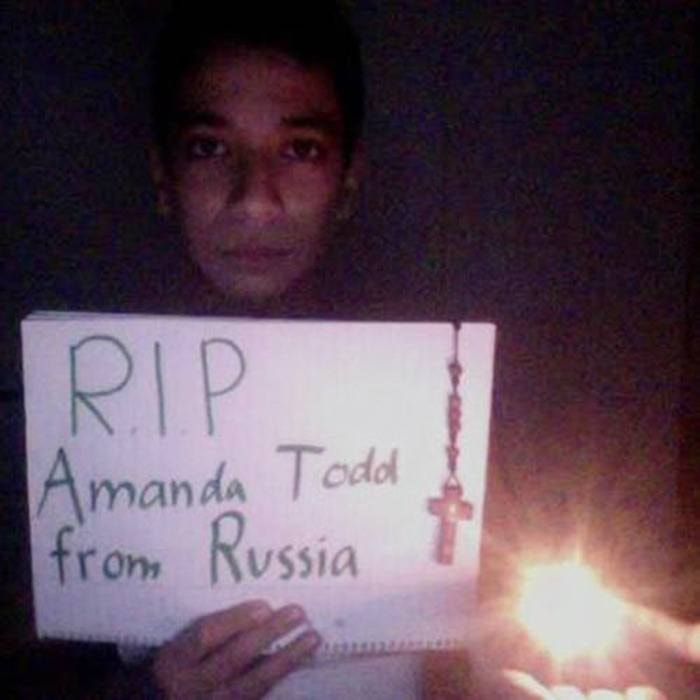The messages and condolences have been coming in from all corners of the globe as the story of tormented teenager Amanda Todd has spread virally via social media, broadcast, and print news.
The Youtube video Todd posted a month prior to her death detailing the harassment she suffered from an online predator and school bullies, how she descended into drug and alcohol abuse, as well as self harm, has been viewed close to 20 million times.
Her story has prompted teens from as far away as Texas and Russia to post messages of sympathy on the many memorial Facebook sites that have popped up in the past week since Todd's death.
Nina Montané is a television journalist with the French news program 66 Minutes, which has sent crews from Paris to the Lower Mainland to cover the tragic tale.
Montané says Todd's video, which has been shared online throughout France and much of Europe, struck a chord with viewers for a number of reasons. Younger viewers identified with the angst Todd expressed in her video, and her feelings of loneliness.
"Her story is a warning message, and I think everyone identifies with what she went through," says Montané. "She was so isolated and she made this SOS, and it didn't really help her. It's sad she only gets the attention now, when it is too late."
However, older viewers, especially parents, are having a different response.
"Older people are really scared by what happened to [Todd], because they don't understand teenagers' habits on the Internet," says Montané. "Many wonder how she could think she wouldn't be recorded [after exposing herself online]."
Social media sites like Facebook and Twitter allowed for the rapid spread of the online video, as both teens and parents shared Todd's story.
"The fact that she made this video on Youtube, everyone across the world could see it," says Montané.
Martin Laba, an associate professor at Simon Fraser University specializing in media and pop culture analysis, is surprised by the global impact of Todd's story.
"You'd have to have been living in a hole to have not heard about her story," says Laba. "It truly went viral, and was particularly driven by social media."
While social media has played a significant role in the spread of Todd's story, it has also created a forum where bullying and harassment runs rampant, as is evidenced by the volume of abuse and criticism of Todd circulating online.
"Social media has democratized media and given access to the public they haven't had before," says Laba. "By the same token, there's an uncontrollable, uncontainable dimension. This case demonstrates those problematic dimensions of social media."
Laba sees Todd's story as an urgent and critical call for education of young people about the nature, consequences, and dangers of social media.
"There are chilling consequences for young people online," he says.
Laba says while the mainstream media response to Todd's story has shone a light on many issues facing today's teenagers, the conversation is often oversimplified.
"The mainstream media has done a very good job of creating a sense of the urgency and the critical nature of this social issue," he says. "But bullying itself is very ill-defined. Mainstream media should be a place where the nuances and complexity of this issue are discussed, but it doesn't allow for such reflection. Instead the mainstream media tend to give us rather simplistic answers, and that does a disservice."
That same media attention has also been an impediment to the police investigation, he notes.
But Todd's story is far from unique, he notes, and it is becoming more common.
Suicide numbers among females aged 10 to 19 have risen from 50 cases in 1980 to 77 in 2008, according to a report published by the Public Health Agency of Canada earlier this year.
What makes what happened to Todd different, said Laba, is the video she published prior to her death, and the role the Internet played, both before and after her death.
"We know that the kind of torment she experienced is epidemic, especially among teens. But the media, particularly broadcast media, needs quick and crisp explanations," explains Laba. In this case, Todd, herself, provided one with her online video.
"The story is so poignant and so terribly tragic ... It was a simple and direct route to what the media and the public often refer to as closure.
"But this is a case that shouldn't be so easily summed up in this way."
Todd's story touches not only on bullying and the dangers of social media, but the sexualization of youth, depression and mental illness as well.
"In the end, we really don't know Amanda Todd, she's a stranger," says Laba. "We have some insight into the torment of her life, but that's all we have."
